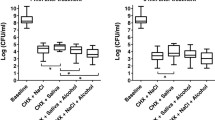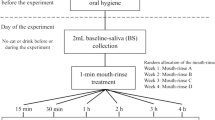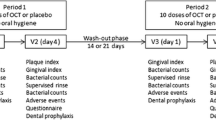Abstract
The in vivo antimicrobial activity of 0.12% and 0.2% chlorhexidine (CHX) on the salivary flora up to 7 h after its application, using epifluorescence microscopy with the SYTO 9/propidium iodide dual staining, was evaluated. Fifteen volunteers performed a single mouthrinse with sterile water (SM-water), a single mouthrinse with 0.12% CHX (0.12% SM-CHX) and a single and double mouthrinse with 0.2% CHX (0.2% SM-CHX and 0.2% DM-CHX). Samples of saliva were taken at 30 s, and 1, 3, 5, and 7 h after each application. In comparison with SM-water, 0.2% CHX (SM and DM) showed a significant antibacterial effect up to 7 h after the mouthrinse, whereas this effect only persisted up to 5 h after the 0.12% SM-CHX mouthrinse. On comparing the two concentrations of CHX, significantly higher percentages of bacterial vitality were observed in all the saliva samples after the use of 0.12% CHX than after 0.2% CHX. On comparison of the 0.2% SM-CHX and 0.2% DM-CHX, significantly higher percentages of live bacteria were observed in the saliva samples taken at 1, 3, 5, and 7 h after the single mouthrinse compared with the double mouthrinse. The 0.2% CHX mouthrinse had the greatest antimicrobial activity on the salivary flora up to 7 h after its application, with a progressive recovery in bacterial vitality. The differences observed with respect to the 0.12% CHX mouthrinse demonstrate the influence of the concentration on its immediate antimicrobial activity and substantivity.

Similar content being viewed by others
References
Manau Navarro C, Guasch Serra S (2003) Métodos de control de la placa bacteriana. In: Cuenca Sala E, Manau Navarro C, Serra Majem L (eds) Odontología preventiva y comunitaria: principios, métodos y aplicaciones, 2nd edn. Masson, Barcelona, p 79
Moran J, Addy M, Wade WG et al (1992) A comparison of delmopinol and chlorhexidine on plaque regrowth over a 4-day period and salivary bacterial counts. J Clin Periodontol 19:749–753
Jenkins S, Addy M, Wade W, Newcombe RG (1994) The magnitude and duration of the effects of some mouthrinse products on salivary bacterial counts. J Clin Periodontol 21:397–401
Elworthy A, Greenman J, Doherty FM, Newcombe RG, Addy M (1996) The substantivity of a number of oral hygiene products determined by the duration of effects on salivary bacteria. J Periodontol 67:572–576
Balbuena L, Stambaugh KI, Ramirez SG, Yeager C (1998) Effects of topical oral antiseptic rinses on bacterial counts of saliva in healthy human subjects. Otolaryngol Head Neck Surg 118:625–629
Addy M, Moran J (1997) Evaluation of oral hygiene products: science is true; don't be misled by the facts. Periodontol 2000 15:40–51
Sekino S, Ramberg P, Uzel NG, Socransky S, Lindhe J (2003) Effect of various chlorhexidine regimens on salivary bacteria and de novo plaque formation. J Clin Periodontol 30:919–925
Roberts WR, Addy M (1981) Comparison of in vitro and in vivo antibacterial properties of antiseptic mouthrinses containing chlorhexidine, alexidine. CPC and hexetidine. Relevance to mode of action. J Clin Periodontol 8:295–310
Addy M, Jenkins S, Newcombe R (1989) Toothpastes containing 0.3% and 0.5% triclosan. II. Effects of single brushings on salivary bacterial counts. Am J Dent 2:215–219
Jenkins S, Addy M, Newcombe R (1990) The effects of 0.5% chlorhexidine and 0.2% triclosan containing toothpastes on salivary bacterial counts. J Clin Periodontol 17:85–89
Schiott CR, Loe H, Jensen SB, Kilian M, Davies RM, Glavind K (1970) The effect of chlorhexidine mouthrinses on the human oral flora. J Clin Periodontol 5:84–89
Addy M, Jenkins S, Newcombe R (1991) The effect of some chlorhexidine-containing mouthrinses on salivary bacterial counts. J Clin Periodontol 18:90–93
Harper PR, Milsom S, Wade W, Addy M, Moran J, Newcombe RG (1995) An approach to efficacy screening of mouthrinses: studies on a group of French products (II). Inhibition of salivary bacteria and plaque in vivo. J Clin Periodontol 22:723–727
Tomás I, Cousido MC, Tomás M, Limeres J, García-Caballero L, Diz P (2008) In vivo bactericidal effect of 0.2% chlorhexidine but not 0.12% on salivary obligate anaerobes. Arch Oral Biol 53:1186–1191
Weiger R, Netuschil L, Wester-Ebbinghaus T, Brecx M (1998) An approach to differentiate between antibacterial and antiadhesive effects of mouthrinses in vivo. Arch Oral Biol 43:559–565
Caballero LG, Carmona IT, Gónzalez MC, Posse JL, Taboada JL, Dios PD (2009) Evaluation of the substantivity in saliva of different forms of application of chlorhexidine. Quintessence Int 40:141–144
World Health Organisation (1997) Oral health surveys, basic methods, 4th edn. WHO, Geneva
Navazesh M, Christensen CM (1982) A comparison of whole mouth resting and stimulated salivary measurement procedures. J Dent Res 61:1158–1162
Tomás Carmona I, García-Caballero L, Cousido M, Limeres J, Álvarez M, Diz P (2009) Evaluation of chlorhexidine substantivity on salivary flora by epifluorescence microscopy. Oral Dis, 2009 Apr 21 [Epub ahead of print].
Pitten FA, Kramer A (1999) Antimicrobial efficacy of antiseptic mouthrinse solutions. Eur J Clin Pharmacol 55:95–100
Herrera D, Roldan S, Santacruz I, Santos S, Masdevall M, Sanz M (2003) Differences in antimicrobial activity of four commercial 0.12% chlorhexidine mouthrinse formulations: an in vitro contact test and salivary bacterial counts study. J Clin Periodontol 30:307–314
Jenkins S, Addy M, Newcombe R (1990) The effect of triclosan, stannous fluoride and chlorhexidine products on: (II) Salivary bacterial counts. J Clin Periodontol 17:698–701
Buckner RY, Kayrouz GA, Briner WW (1994) Reduction of oral microbes by a single chlorhexidine rinse. Compendium 15:512–520
Briner WW, Kayrouz GA, Chanak MX (1994) Comparative antimicrobial effectiveness of a substantive (0.12% chlorhexidine) and a nonsubstantive (phenolic) mouthrinse in vivo and in vitro. Compendium 15:1158–1170
Fernandes-Naglik L, Downes J, Shirlaw P et al (2001) The clinical and microbiological effects of a novel acidified sodium chlorite mouthrinse on oral bacterial mucosal infections. Oral Dis 7:276–280
Jenkins S, Addy M, Newcombe R (1991) Triclosan and sodium lauryl sulphate mouthwashes (I). Effects on salivary bacterial counts. J Clin Periodontol 18:140–144
Reynolds S, Moran J, Addy M, Wade WG, Newcombe R (1991) Taurolin as an oral rinse. I. Antimicrobial effects in vitro and in vivo. Clin Prev Dent 13:13–17
Simonsson T, Hvid EB, Rundegren J, Edwardsson S (1991) Effect of delmopinol on in vitro dental plaque formation, bacterial acid production and the number of microorganisms in saliva. Oral Microbiol Immunol 6:305–309
Moran J, Addy M, Wade W, Milson S, McAndrew R, Newcombe RG (1995) The effect of oxidising mouthrinses compared with chlorhexidine on salivary bacterial counts and plaque regrowth. J Clin Periodontol 22:750–755
Milstone AM, Passaretti CL, Perl TM (2008) Chlorhexidine: expanding the armamentarium for infection control and prevention. Clin Infect Dis 46:274–281
Sreenivasan PK, Gittins E (2004) Effects of low dose chlorhexidine mouthrinses on oral bacteria and salivary microflora including those producing hydrogen sulfide. Oral Microbiol Immunol 19:309–313
Dahlen G (1984) Effect of antimicrobial mouthrinses on salivary microflora in healthy subjects. Scand J Dent Res 92:38–42
Addy M, Wright R (1978) Comparison of the in vivo and in vitro antibacterial properties of povidone iodine and chlorhexidine gluconate mouthrinses. J Clin Periodontol 5:198–205
Yates R, Moran J, Addy M, Mullan PJ, Wade WG, Newcombe R (1997) The comparative effect of acidified sodium chlorite and chlorhexidine mouthrinses on plaque regrowth and salivary bacterial counts. J Clin Periodontol 24:603–609
Toljanic JA, Hagen JC, Takahashi Y, Shapiro RD (1992) Evaluation of the substantivity of a chlorhexidine oral rinse in irradiated head and neck cancer patients. J Oral Maxillofac Surg 50:1055–1059
Conflict of interest
The authors declare that they have no conflict of interest.
Author information
Authors and Affiliations
Corresponding author
Rights and permissions
About this article
Cite this article
Cousido, M.C., Tomás Carmona, I., García-Caballero, L. et al. In vivo substantivity of 0.12% and 0.2% chlorhexidine mouthrinses on salivary bacteria. Clin Oral Invest 14, 397–402 (2010). https://doi.org/10.1007/s00784-009-0320-2
Received:
Accepted:
Published:
Issue Date:
DOI: https://doi.org/10.1007/s00784-009-0320-2




